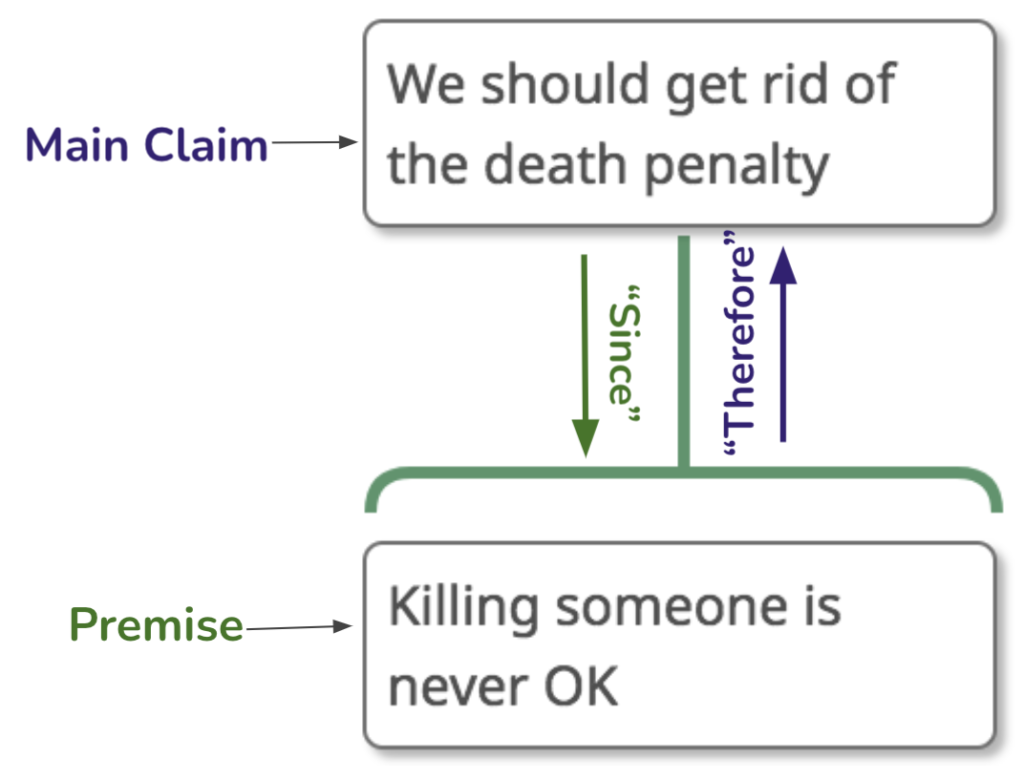What is an Argument?
- Argument: Communication in which the speaker is trying to persuade their audience to believe, feel or do something by giving reasons.
- vs. Fight: In a fight, the speaker is just trying to get their way, regardless of whether or not they change their audience’s mind or persuade them to agree.
- vs. Description: In a description, the speaker explains what happened, gives information, or tells a story. Their goal is to inform or entertain the audience, rather than convince the audience of a main point.
- Why We Argue:
- Truth
- Justice
- Connection
- Skills
- How We Argue: The dispositions of strong critical thinkers
- Humility (“I could be wrong”)
- Openness (“You could be right”)
- Value having good reasons for your beliefs
- The Charity Principle: Treat other people’s arguments how you want them to treat yours
Argument Components
- Claim: A statement that someone wants you to believe.
- Main Claim: The main point of the argument; the primary thing the speaker wants the audience to believe.
- Premise: A claim that gives a reason to believe another claim.
- Evidence: Concrete, specific factual information presented to support a claim, e.g. quote from a text, historical source, piece of data
- Reasoning: Explains how/why the evidence helps to prove the claim.
- Objection: A claim that gives a reason not to believe another claim.
- Rebuttal: A response to an objection.
Indicator Words
| Main Claim | Premise | Objection |
| Therefore | Since | However |
| So | Because | But |
| Thus | Seeing as | Yet |
| Hence | Given that | Even though |
| Ergo | Consider that | Although |
| Accordingly | In light of | Critics say |
| As such | First/second/third, additionally, furthermore, also, moreover, besides, etc. | On the other hand |

The Reason Rule
In an argument map, every single premise must always answer the question “why believe this?” about the claim above it. (You should only include a statement in your map if it gives a reason to believe the statement above it.)
Argument Structure Types
Independent Premises: give you separate, distinct reasons to believe the claim above.

Sub-Premise: a premise that gives you a reason to believe another premise. Arguments with at least one sub-premise are called chain arguments.

Co-Premises: work together or “hold hands” to give one single reason to believe the claim above. (Think of two people making a chair with their hands to carry someone else.)

- Each co-premise logically connects the other co-premise to the claim above. It spells out how the other co-premise is relevant to the claim above.
- If one co-premise is false, the other co-premise does not work as a reason to believe the claim. (Whereas independent premises still work as a reason, even if the other premise is false).
- Hidden co-premise: A co-premise that the author assumes but does not explicitly state in their argument. (Often, the true source of a disagreement lies in hidden assumptions.)
- One common form of co-premises is Evidence+Reasoning (see definitions above).
Evaluating Arguments
Two-step test:
1. Are the premises true or false? (How plausible/ reasonable are they?)
2. Are the inferences strong or weak?
| 1. Premises/ Evidence ( = building materials) | 2. Inferences ( = structural design) | |
| Good | True (probable, reasonable) | Strong (relevant, sufficient) |
| Bad | False (improbable, unreasonable) | Weak (irrelevant, insufficient) |
- Are the premises relevant to why you should believe the main claim?
- Do the premises give you a sufficient reason to believe the main claim?
- Remember, an argument can have true premises with weak inferences (solid materials, bad design), or false premises with strong inferences (lousy materials, good design) or both/neither.
What makes an argument good?
- State a clear main claim
- Use true premises
- Given a choice, try to appeal to the audience
- For empirical (descriptive) claims:
- Give examples to clarify and illustrate
- Cite evidence from reliable sources
- Explain the relevance of the premises to supporting the main claim
- Be explicit about key assumptions
- Use precise, specific, and moderate language
- (Generally) Offer multiple independent lines of reasoning
- (Generally) Consider and respond to at least one objection

